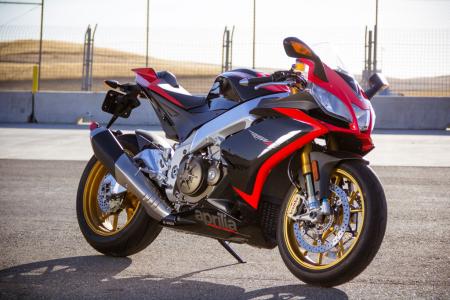2012 Aprilia RSV4 Factory APRC Track Review - Motorcycle.com
If you’ve been following our escapades here at Motorcycle.com for a while, you’ll notice our affinity towards Aprilia’s RSV4. We’ve tested the base R version numerous times and for good reason – it’s one of our favorite sportbikes in recent memory. Not so much for one particular category, but more so because of its overall package.
We’re fond of its supremely precise chassis and its snarling, communicative power delivery. Though it hasn’t quite taken the objective victory in our literbike shootouts, many of us on staff would choose it as our subjective favorite. Now, with Max Biaggi reclaiming the World Superbike title by half a point over Tom Sykes aboard a Kawasaki ZX-10R this year, we’re taking another look at the R’s more sophisticated sibling – the RSV4 Factory APRC, the machine which took Max to his sixth world championship title.
While it shares the same aluminum frame, 65-degree, 999cc V-Four engine and sophisticated traction/wheelie/launch control as the R model, there are some significant differences between the two which gives the Factory a sharper edge. For starters, there’s the $6000 price difference ($22,999 vs. $16,999). It may sound steep, but here are the main differences between the two:
| Dueling RSV4s | ||||
| RSV4 Factory APRC | RSV4 R APRC | |||
| Ohlins fully adjustable suspension | Sachs fully adjustable suspension | |||
| Adjustable engine mounting points, swingarm pivot and steering angle | Fixed engine mounting point, swingarm pivot and steering angle | |||
| Magnesium valve, clutch and stator covers | Aluminum valve, clutch and stator covers | |||
| Forged aluminum wheels | Cast aluminum wheels | |||
| Electronically adjustable intake stacks | Fixed intake stacks (though wiring for the variable intake control module is included if you want to upgrade) | |||
| Pirelli Diablo Supercorsa tires, 120/70-17 front, 200/55-17 rear | Metzeler Racetec Interact tires, 120/70-17 front, 190/55-17 rear | |||
| Carbon fiber front/rear fenders and side panels | Plastic front/rear fenders and side panels | |||
| Red/black paint scheme | White or black paint scheme | |||
| Curb weight: 464.0 lbs. | Curb weight: 473.0 lbs. | |||
So obviously, the big question is whether the significant price jump is worth it. Looking at the numbers, the standard R model put out 156.9 hp and 73.2 ft.-lbs of torque at 12,600 and 10,100 rpm, respectively, during our 2012 European Literbike Shootout. Meanwhile, we recently ran the Factory version on the drum to the tune of 160.4 hp and 75.8 ft.-lbs at 12,750 and 10,250 rpm, respectively. So the difference in power alone isn’t enough to make a convincing argument for choosing the Factory version.
The number to really pay attention to, however, is curb weight. Not only does the Factory model weigh 9 lbs. less than the R, but much of the weight savings comes from the forged wheels compared to the R’s cast units, which themselves, Aprilia says, are lighter than the 2010 R units. The benefits are multiplied when shaving unsprung, rotating weight, as it positively affects every performance aspect.
Not that the R is a slug by any means, but riding the Factory, especially in a racetrack setting, truly brings the weight saving measures to light. The chassis is already one of the most precise instruments we’ve sampled, which is made even more accurate with the forged wheels. Direction changes take but a mere thought to accomplish.
From a suspension standpoint, the biggest advantage the Factory Ohlins bits offer over the Sachs units of the R is the degree of adjustability. The Ohlins fork also features a Titanium Nitride coating for reduced stiction. Personally, while these things sound impressive on paper, when setup properly, neither fellow cohort Tom Roderick nor I are talented enough to notice a major difference.
The added power may not be much, but is surely welcome and delivered in the same communicative fashion we know and love. Eight traction control settings, allowing no slip or extreme slip, are easily manipulated via paddles operated by the left thumb or index finger and can be done on the fly. Then there’s the included wheelie and launch control to make its rider feel just like Mad Max Biaggi. Brembo monoblocs on both models bite with authority and feel.
Look again at the table above and you’ll notice the amount of adjustability on the Factory model, with engine placement, swingarm pivot and steering angle all customizable by the owner. “While they do add value to the bike and help to justify its price, how many street riders, trackday pilots or even amateur racers are truly able to take advantage of what these adjustments have to offer?” asks Roderick.
It’s a valid point, to which Tom says: “The Factory and R model RSVs look, sound and perform so similarly and offer the same electronics package that for the $6000 price difference, I'd be more than happy purchasing the R version.”
However, Tom did note, money not a factor, the Factory would be his pick, which is a unanimous choice amongst our staff. Should you be chasing lap times, its performance advantage over the R is significant, and in this money-is-no-object dream world, it would also make an alluring decorative piece to anyone’s garage. Stay tuned as we compare it to another example of motorcycle art, the MV Agusta F4 RR Corsacorta.
Related Reading
2012 European Literbike Shootout - Video
2012 European Literbike Shootout Teaser - Video
2012 Yamaha YZF-R1 vs. 2011 Aprilia RSV4 R APRC - Video
2011 Aprilia RSV4 Factory APRC SE Review
2010 Aprilia RSV4 R Review
2010 Literbike Shootout: RSV4 R vs S1000RR vs CBR1000RR vs ZX-10R
2010 Literbike Shootout: Aprilia RSV4 Factory vs. Ducati 1198S vs. KTM RC8R
Italian V-Four Literbike Shootout: Aprilia RSV4 Factory vs. Ducati Desmosedici - Video
More by Troy Siahaan

































Comments
Join the conversation